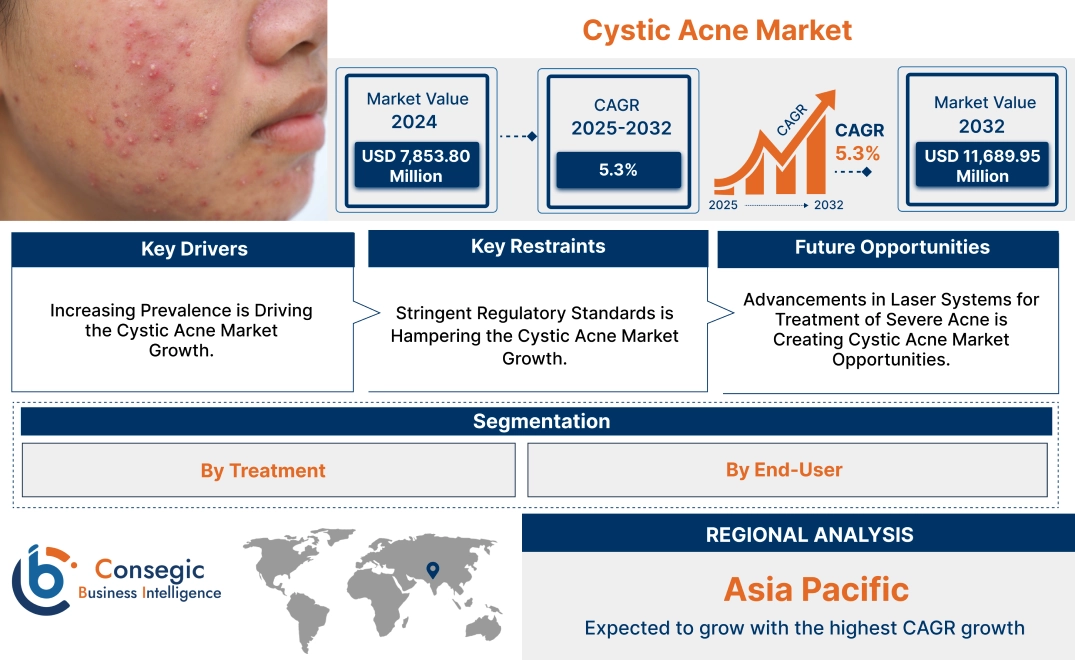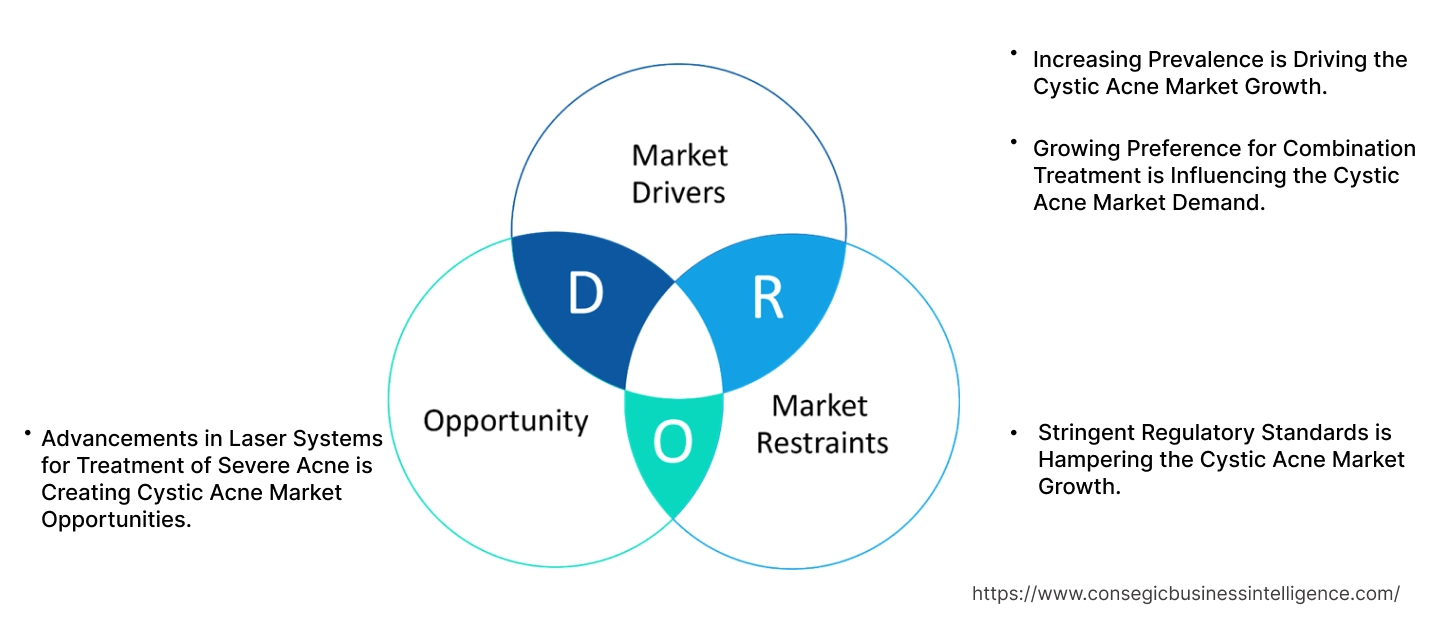Cystic Acne Market Size:
Cystic Acne Market size is growing with a CAGR of 5.3% during the forecast period (2025-2032), and the market is projected to be valued at USD 11,689.95 Million by 2032 from USD 7,853.80 Million in 2024.
Cystic Acne Market Scope & Overview:
Cystic acne is a particularly severe form of acne that occur as large, painful, pus-filled lumps, known as cysts, beneath the surface of the skin. Unlike milder forms of acne, cystic acne involves significant inflammation deeply rooted in the skin's layers, leading to the formation of these swollen and tender nodules. This condition is most prevalent among adolescents and young adults, primarily due to fluctuations in hormone levels during puberty, which leads to increased oil production in the skin. Genetic factors play a crucial role in developing cystic acne. Additionally, certain medications, such as steroids, exacerbate acne symptoms by altering the hormonal balance in the body or increasing oil secretion.
Cystic acne mainly requires more intensive treatment compared to other types of acne due to its painful nature and potential for scarring. Therapeutic options include prescription medications, such as oral antibiotics, hormonal therapies, and others, as well as topical treatments aimed at reducing inflammation and clearing clogged pores. The treatment options mainly consist of topical medications like retinoids and benzoyl peroxide and others including procedures like laser therapy, chemical peels, and microneedling among others. End-users primarily include hospitals and dermatology clinics among others.
Cystic Acne Market Dynamics - (DRO) :
Key Drivers:
Increasing Prevalence is Driving the Cystic Acne Market Growth.
The escalating prevalence of cystic acne is a key driver of market. Cystic acne, a severe form of acne that occurs when clogged pores become infected deep within the skin. Cystic acne disproportionately affects adolescents and young adults due to the significant hormonal fluctuations experienced during puberty. Increased androgen levels stimulate sebum production, leading to clogged pores and creating an environment conducive to bacterial growth. These hormonal shifts, characteristic of this developmental stage, play a crucial role in the development and severity of cystic acne.
- According to the data published by the National Center for Biotechnology Information, in June 2023, stated that the prevalence of acne in adolescents is about 80% worldwide with 20% of severe acne such as cystic acne. Adult acne is estimated to be 40% of the affected population worldwide.
Hence, this widespread condition necessitates effective treatment options, fueling demand for medications, therapies, and procedures aimed at managing and mitigating the impact of cystic acne.
Growing Preference for Combination Treatment is Influencing the Cystic Acne Market Demand.
A growing preference for combination therapies is significantly driving the market demand. This shift in treatment approaches recognizes the multifaceted nature of the condition. By combining different treatment modalities, such as topical retinoids, oral antibiotics, and laser therapy, healthcare providers address the various underlying factors contributing to cystic acne, including excess oil production, bacterial overgrowth, and inflammation. Manufacturers are developing novel combination medications that consist of a combination of two or more active ingredients in the topical form for treating acne.
- In October 2023, FDA approved IDP-126 Cabtreo gel by Bausch Health for the treatment of acne in patients above 12 years of age. It is a triple combination gel consisting of clindamycin phosphate 1.2%, adapalene 0.15%, and benzoyl peroxide 3.1%. It is stated to be the first FDA-approved fix-dosed triple combination gel. This gel effectively treats mild form to cystic type of acne.
In conclusion, the market is significantly influenced by the growing preference for combination therapies. Moreover, the development of novel combination medications, integrating multiple active ingredients in topical formulations, offers a convenient and potentially more effective treatment option for patients.
Key Restraints:
Stringent Regulatory Standards is Hampering the Cystic Acne Market Growth.
Stringent regulatory standards imposed by government bodies worldwide pose significant constraints in the market. These regulations, designed to protect the environment and public health, increase production costs and slow down product development. The development and approval of new acne treatments, particularly pharmaceuticals and medical devices, involve rigorous processes to ensure safety and efficacy. These processes are time-consuming and costly, potentially hindering the introduction of innovative therapies and delaying patient access to the most effective treatment options.
Compliance with these regulations increases the cost of product development and testing. These regulations also result in significant disruptions to traditional industry supply chains and loss of current raw materials uses. Moreover, evolving federal regulations accelerate annual compliance and operating costs throughout healthcare industry supply chains. Thus, the impact of these stringent regulations on the cystic acne market expansion is multifaceted.
Future Opportunities :
Advancements in Laser Systems for Treatment of Severe Acne is Creating Cystic Acne Market Opportunities.
Advancements in laser systems for acne treatment are creating significant opportunities within the cystic acne market. Newer laser technologies offer improved precision, reduced side effects, and enhanced efficacy in targeting acne lesions. These advancements include fractional lasers that penetrate deeper into the skin to treat inflammation and stimulate collagen production, as well as lasers that specifically target and destroy the bacteria that contribute to acne. These innovative laser systems provide dermatologists with more effective tools to treat severe acne, including cystic acne, leading to increased market demand for these advanced technologies. Manufacturers are developing novel laser systems for the treatment of severe acne conditions.
- In October 2024, Accure Acne, Inc received for their Accure Laser System for the long-term treatment of mild to severe inflammatory acne vulgaris, including cystic acne. This innovative system leverages the unique properties of the 1726 nm laser wavelength. Combined with Accure Acne's proprietary technology, the Accure Laser System precisely controls the depth of thermal impact, specifically targeting the sebaceous glands, a key factor in the development of cystic acne. This targeted approach offers a potentially promising avenue for long-term management of severe acne.
Thus, as per the market analysis, the rise in the development of novel laser systems is creating lucrative cystic acne market opportunities.
Cystic Acne Market Segmental Analysis :
By Treatment:
Based on treatment, the market is categorized into topical medication, oral medication, laser therapy, chemical peel, microneedling, and others.
Trends in the Treatment:
- Growing trend for minimally invasive opting for targeting specific acne.
- The development of overnight acne patches is influencing segment growth.
The oral medications segment accounted for the largest market share in 2024.
- The oral medication segment is further categorized into antibiotics, hormonal medications, and others.
- Oral medications are a common treatment option for cystic acne, particularly when topical treatments prove ineffective.
- These medications target various aspects of acne development, such as bacterial overgrowth, excess oil production, and inflammation.
- Antibiotics like tetracycline and doxycycline are commonly prescribed to reduce the bacteria that contribute to acne breakouts.
- Hormonal medications, such as birth control pills or spironolactone, are effective in women by regulating hormone levels that influence oil production.
- Isotretinoin is a medication derived from vitamin A, is mainly used for severe, recalcitrant cystic acne.
- Manufacturers are introducing isotretinoin medication for the treatment of severe acne.
- For instance, in December 2023, Sun Pharma Canada Inc announced the launch of (PR)ABSORICA LD (isotretinoin capsules) in Canada. (PR)ABSORICA LD is indicated for the treatment of severe nodular and inflammatory acne, acne conglobata, and recalcitrant acne in patients 12 years of age and older.
- Overall, based on the market analysis, oral medications offer a valuable treatment option for cystic type of acne. These medications target various aspects of acne development, including bacterial overgrowth, excess oil production, and inflammation.
The laser therapy segment is expected to grow at the fastest CAGR over the forecast period.
- Laser therapy offers a promising approach for treating cystic acne. Different types of lasers, such as blue light lasers and intense pulsed light (IPL) therapy, effectively target the bacteria that contribute to acne breakouts.
- These lasers work by emitting specific wavelengths of light that are absorbed by the bacteria, killing them and reducing inflammation.
- Laser therapy also helps to reduce oil production and improve the overall appearance of the skin.
- Various manufacturers are offering novel laser therapy solutions for proper treatment of severe acne.
- Overall, as per the market analysis, laser therapy has emerged as a valuable tool in the management of cystic type of acne acne. By targeting the underlying causes of acne, such as bacterial overgrowth and excess oil production, laser treatments offer a potential alternative or adjunct to traditional medications. The continuous development and refinement of laser technologies by manufacturers provide dermatologists with increasingly effective and precise options for treating this condition.
By End-User:
Based on end user, the market is categorized into hospitals, dermatology clinics, and others.
Trends in the End User:
- Rise in the number of dermatology clinics is influencing the segment trends.
- The growing trend for procedures such as chemical peels and lasers is influencing the requirement of hospitals and clinics
The hospital segment accounted for the largest market share of 48.15% in the year 2024.
- Hospitals play a crucial role as end-users in the acne treatment market. They provide comprehensive care for patients with severe acne, including cystic type of acne, which mainly requires specialized medical expertise and advanced treatment options.
- Hospitals typically employ dermatologists and other specialists who accurately diagnose and manage complex cases, including those resistant to over the counter or milder treatments.
- They mainly have access to a wider range of therapeutic options, including injectable medications, laser therapies, and advanced procedures, enabling them to provide personalized treatment plans tailored to individual patient needs.
- Furthermore, hospitals serve as referral centers for patients with severe or treatment-resistant acne, facilitating access to the most advanced and effective care available.
- Overall, as per the market analysis, hospitals play a pivotal role in the acne treatment market by providing comprehensive care for patients with severe acne. Their expertise, access to advanced treatment options, and function as referral centers ensure that patients with this challenging condition receive the most effective and personalized care, ultimately improving treatment outcomes and quality of life.
The dermatology clinics segment is expected to grow at the fastest CAGR over the forecast period.
- Dermatology clinics are a primary end-user segment in the acne treatment market.
- These clinics specialize in the diagnosis and treatment of skin conditions, including acne, and are mainly the first point of contact for patients seeking professional care.
- Dermatologists possess in-depth knowledge of acne pathophysiology and have access to a wide array of treatment options, including topical medications, oral medications, and minimally invasive procedures like chemical peels and laser therapy.
- They accurately assess the severity of acne, including cystic acne, and tailor treatment plans to individual patient needs and preferences.
- Furthermore, dermatology clinics mainly foster a patient-centered approach, providing ongoing monitoring, support, and adjustments to the treatment regimen as needed, ensuring optimal outcomes for patients with severe acne.
- Various novel dermatology clinics are introduced to provide accurate treatment for severe acne.
- For instance, in June 2024, Kosmoderma, launched its newest clinic in India, introducing cutting-edge technologies to the Indian market. This expansion signifies a significant step in providing patients with access to the latest advancements in skincare and aesthetic treatments, further solidifying Kosmoderma's position as a leader in the field.
- Thus, the aforementioned factors are influencing the cystic acne market trends in the coming years.
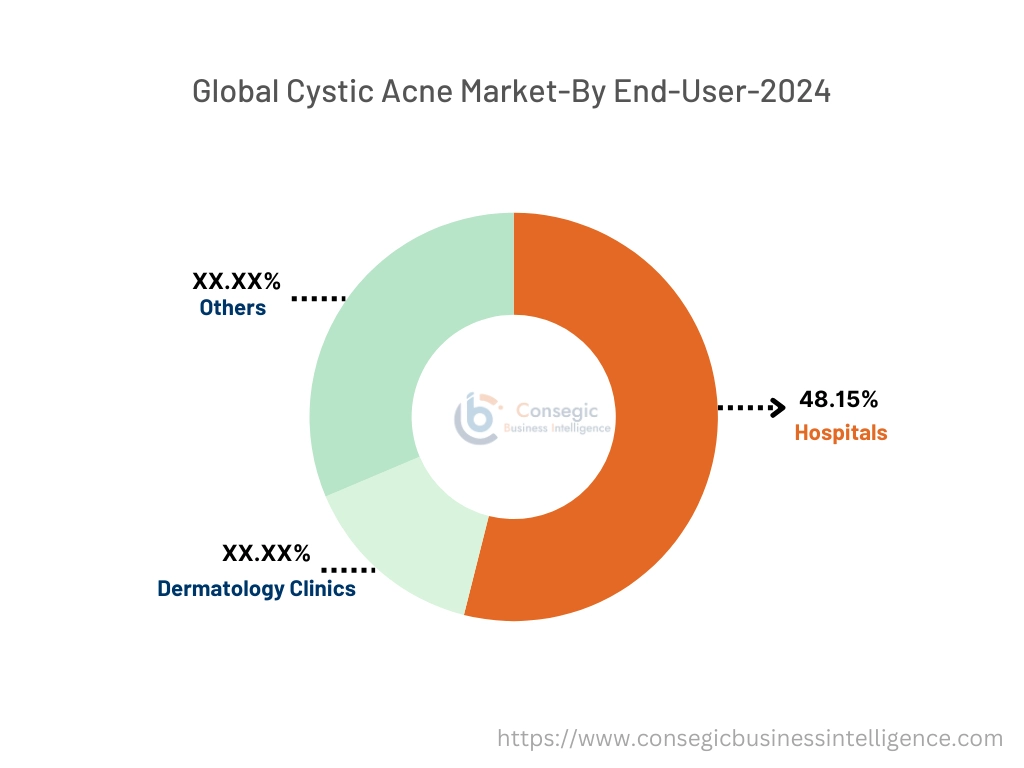
Regional Analysis:
The regional segment includes North America, Europe, Asia Pacific, the Middle East and Africa, and Latin America.
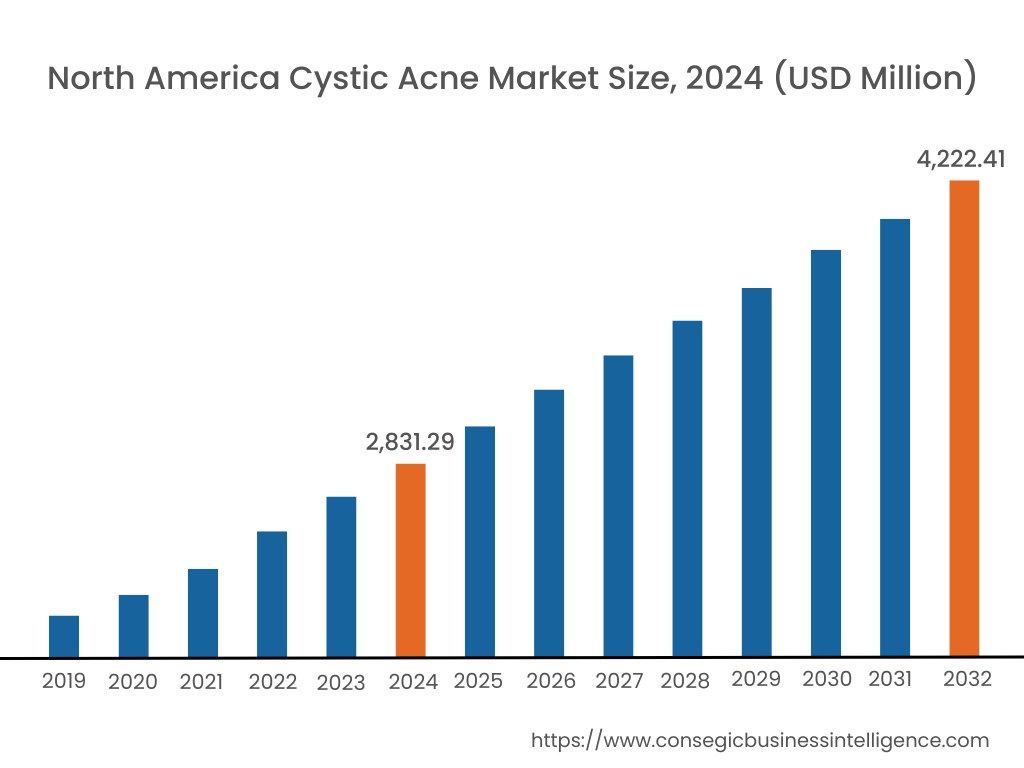
In 2024, North America accounted for the highest cystic acne market share at 36.05% and was valued at USD 2,831.29 Million and is expected to reach USD 4,222.41 Million in 2032. In North America, U.S. accounted for the highest share of 75.11% during the base year of 2024. Cystic type of acne is a prevalent and significant concern in North America, affecting a substantial portion of the population, particularly adolescents and young adults. This severe form of acne is characterized by deep, painful, and mainly pus-filled cysts that can cause significant emotional distress and lead to scarring. Treatment options for cystic type of acne in North America are diverse and include topical medications (retinoids, benzoyl peroxide), oral medications (antibiotics, hormonal therapies, isotretinoin), and procedures such as laser therapy, chemical peels, and microneedling. Access to healthcare, including dermatological care, is generally good in many parts of North America, allowing for effective diagnosis and management of cystic type of acne. Manufacturers are introducing novel acne treatment solutions in the North America region.
- In June 2021, Sol-Gel Technologies and Galderma that provide solutions for acne have announced exclusive licensing agreements for the commercialization of EPSOLAY® (benzoyl peroxide) and TWYNEO® (clindamycin phosphate and tretinoin) in the United States. These agreements signify a significant step forward in providing dermatologists with access to innovative acne treatment options, including for severe forms such as cystic type of acne.
Thus, as per the cystic acne market analysis, the rise in the treatment facilities for cystic type of acne is influencing the cystic acne market trends in this region.
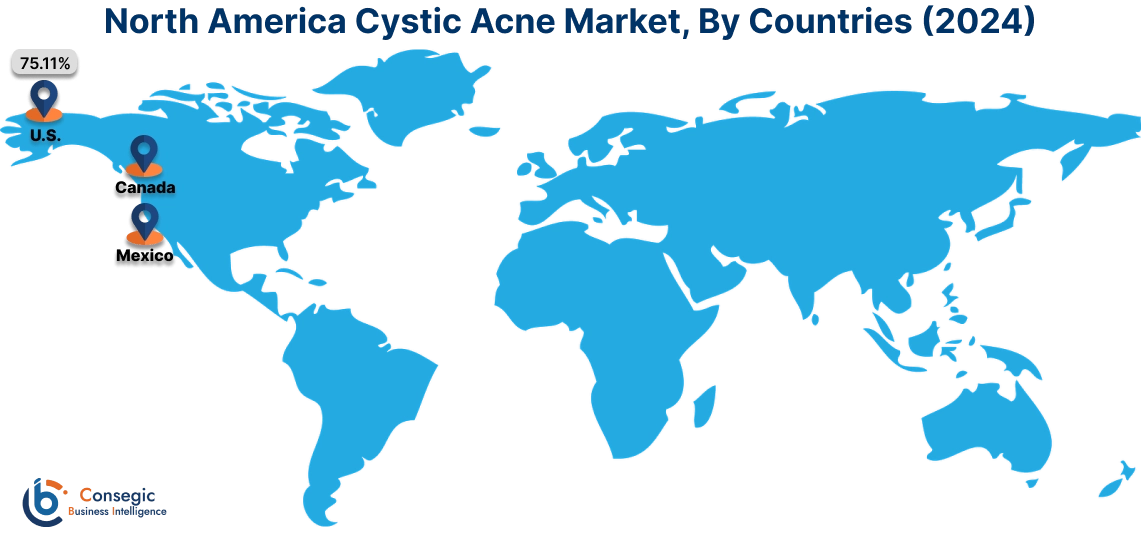
Asia Pacific is experiencing the fastest growth with a CAGR of 5.7% over the forecast period. Cystic acne is a significant public health concern across the Asia-Pacific region. The prevalence of acne, including severe forms like cystic type of acne, varies across countries within the region due to factors such as cultural practices, dietary habits, and environmental influences. Treatment options in the Asia-Pacific region include a range of approaches, from traditional herbal remedies to modern medical therapies. These include topical medications, oral antibiotics, hormonal therapies, and in some cases, procedures like laser therapy and chemical peels. Developed economies like Japan, South Korea, and Singapore boast advanced healthcare systems with well-equipped dermatology departments and access to modern treatments. Thus, based on the cystic acne market analysis, these factors are influencing the cystic acne market expansion and trends in the coming years.
Cystic acne treatment in Europe generally reflects high-quality healthcare standards. Access to a wide range of treatment options is available, including topical medications (retinoids, benzoyl peroxide), oral medications (antibiotics, hormonal therapies, isotretinoin), and procedures such as laser therapy, chemical peels, and microneedling. Europe boasts a strong network of dermatologists and other healthcare professionals specializing in acne treatment, ensuring that patients have access to expert care and personalized treatment plans. Additionally, advancements in research and technology within Europe continue to drive the development of new and improved therapies for cystic type of acne. Thus, these factors are influencing the market development in this region.
The Middle East and Africa (MEA) regions are witnessing notable cystic acne market demand characterized by significant potential. Acne treatment in the Middle East and Africa presents a diverse landscape. In countries with well-developed healthcare systems, such as the United Arab Emirates and South Africa, access to modern treatments, including laser therapy, oral medications, and injectable therapies, is generally good. The increase in research activities by leading companies collectively boosted the market for acne treatment across the region and creating lucrative factors for the acne treatment market in Middle East and Africa. Moreover, cultural factors, socioeconomic disparities, and limited access to quality healthcare infrastructure pose challenges in effectively managing cystic types of acne in these regions.
Latin America is an emerging region in the cystic Acne market share, with significant potential for innovation. A significant portion of the population, particularly adolescents and young adults, experiences acne, including severe forms like cystic type of acne. This substantial patient pool creates a significant market demand for effective treatment options. Furthermore, there is a growing awareness of aesthetic concerns among the Latin American population, coupled with an increasing interest in improving skin health. This heightened awareness drives individuals to seek professional dermatological care and explore a range of treatment options to address their acne concerns. Additionally, the expanding medical tourism industry in some Latin American countries attracts patients from other regions seeking access to high-quality and affordable dermatological treatment.
Top Key Players and Market Share Insights:
The global cystic acne market is highly competitive with major players providing precise products to the national and international markets. Key players are adopting several strategies in research and development (R&D) and product innovation to hold a strong position in the global cystic acne market. Key players in the market include-
- Teva Pharmaceuticals USA (United States)
- Glenmark Pharmaceuticals U.S (United States)
- Hoffmann-La Roche Ltd (Switzerland)
- Bausch Health Companies Inc (Canada)
- Perrigo (United States)
- Sun Pharmaceutical Industries (India)
- Sanify Healthcare (India)
- Zydus Lifesciences (India)
- Galderma (Switzerland)
- Pfizer (United States)
Recent Industry Developments :
Product Launch:
- In October 2024, Accure Acne, Inc received for their Accure Laser System for the long-term treatment of mild to severe inflammatory acne vulgaris, including cystic type of acne acne. This innovative system leverages the unique properties of the 1726 nm laser wavelength. Combined with Accure Acne's proprietary technology, the Accure Laser System precisely controls the depth of thermal impact, specifically targeting the sebaceous glands, a key factor in the development of cystic type of acne. This targeted approach offers a potentially promising avenue for long-term management of severe acne.
- In October 2023, FDA approved IDP-126 Cabtreo by Bausch Health for the treatment of acne in patients above 12 years of age. It is a triple combination gel consisting of clindamycin phosphate 1.2%, adapalene 0.15%, and benzoyl peroxide 3.1%. It is stated to be the first FDA-approved fix-dosed triple combination gel. This gel effectively treats mild form to cystic type of acne.
Cystic Acne Market Report Insights :
| Report Attributes | Report Details |
| Study Timeline | 2019-2032 |
| Market Size in 2032 | USD 11,689.95 Million |
| CAGR (2025-2032) | 5.3% |
| By Treatment |
|
| By End-User |
|
| By Region |
|
| Key Players |
|
| North America | U.S. Canada Mexico |
| Europe | U.K. Germany France Spain Italy Russia Benelux Rest of Europe |
| APAC | China South Korea Japan India Australia ASEAN Rest of Asia-Pacific |
| Middle East and Africa | GCC Turkey South Africa Rest of MEA |
| LATAM | Brazil Argentina Chile Rest of LATAM |
| Report Coverage |
|
Key Questions Answered in the Report
How big is the Cystic Acne market? +
In 2024, the Cystic Acne market is USD 7,853.80 Million.
Which is the fastest-growing region in the Cystic Acne market? +
Asia Pacific is the fastest-growing region in the Cystic Acne market.
What specific segmentation details are covered in the Cystic Acne market? +
Treatment and End User segmentation details are covered in the Cystic Acne market.
Who are the major players in the Cystic Acne market? +
Teva Pharmaceuticals USA (United States), Glenmark Pharmaceuticals U.S (United States), Sun Pharmaceutical Industries (India) are some of the major players in the market.
